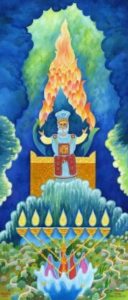Parshat Vayishlach 2021
By Rabbi Moshe Goodman, Kollel Ohr Shlomo, Hebron
בס”ד
לשכנו תדרשו
Discover the Holy Presence in Our Holy Land
Kings Shall Come From You

When Yakov returns to the Land of Israel in this parsha and fulfills his vow at Bet El, he is promised by Hashem that “kings will come from you.” Also, the end of this parsha mentions the kings of Esav that “ruled before the ruling of the kings of Israel.” Indeed, as the haftora also describes, initially political power will be manifest among Esav, but then this power will be overturned in favor for Israel, the righteous People, and the Kingdom of Heaven. The crown is a symbol of kingship, and Israel are crowned, as our Sages teach, by three crowns: the crown of priesthood, the crown of kingship, and the crown of Torah. Although our Sages regard the crown of Torah as superior to the other crowns and also it is a crown that can be reached by the entirety of Israel unlike the other crowns, neverthless we do do see that the entirety of Israel are coined “a crown of priests and a holy nation” in parshat Yitro. This matter entails that all Israel have a connection to the priesthood, I.e the Temple, to some extent. For example, all Israel are supposed to make pilgrimage to the Temple three times a year on the “shloshet regalim.” Also, for Hakhel, just after the end of Shemitah year, all Israel, including women and children, ascend to the Temple. The theme of kingship and rule may be hinted in these matters as well, for the Torah says that other nations will covet the Land of Israel when/in merit Israel makes pilgrimage to the Temple, this being, of course, a strengthening of Israel’s sovereignty and rule in the Land. Also, during the Hakhel ceremony it is the king that leads the ceremony, reading sections of the book of Dvarim before the People. Although, unfortunately we do not have the Temple today, we can strengthen ourselves in uttering the verses of the offerings in the Temple and the study of the matters and laws of the Temple. By so doing, our Sages teach, we are considered as if offering offerings in the Temple. Also the entire Land of Israel is called the “House of Hashem” (see Hulin 92a), I.e resembling the Temple, which entails that strengthening Israel’s power in the Land of Israel is also an important “building block” towards the building of our Temple. Hebron, the cradle of the Davidic monarchical line and Beacon of the Holy Land, is an important part of this empowerment of our Holy Land.
In regard to Nachshon’s painting here, Nachshon himself tied it to our title quote from this parsha. We see the image of the high priest which can be indicative of Israel’s “priestly” leadership of the world at large, as we just explained. We see the palms of the priest opened to the heavens, hinting to the Kabbalistic practice of opening the palms during prayer for blessing and sustenance in the verse “poteach et yadecha.” This hints to the blessing inherent in the service of the Temple, for these palms in the painting are the same form as the flames ascending from the altar towards the heavens (this theme of palms turning into flames can be seen in numbers of Nachshon’s paintings). Also, from the bottom of the painting we see blue flames in the form of people [perhaps the three Patriarchs?], apparently robed in their tallit. From this inference we may also interpret the flames ascending from the altar to refer to the souls of Israel which ascend and unite with the Heavenly spheres through the offerings in the Temple – “the flame of Hashem is the soul of man”. )Mishlei 20, 27)